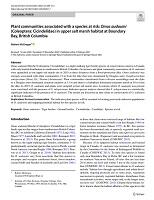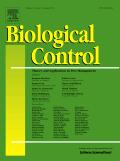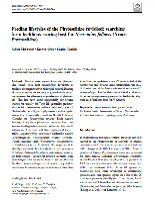McGregor, Robert
Person Preferred Name
Robert McGregor
Affiliation
Related Works
Content type
Digital Document
Abstract
Omus audouini Reiche (Coleoptera: Cicindelidae) is a night-stalking tiger beetle species of conservation concern in Canada with only limited distribution in southwestern British Columbia. Occurrence and plant community associations of O. audouini were quantified at one upper salt marsh site in 2018 at three distances from a flood-protection dike. Omus audouini was strongly associated with plant communities 15 m from the dike that were dominated by Douglas aster, Symphyotrichum subspicatum (Nees) G.L. Nesom (Asteraceae). Plant communities transitioned from a diverse assemblage near the dyke to a Douglas aster dominated estuarine meadow at 15 m and then to a halophyte dominated estuarine marsh at 30 m from the dike. In 2019, O. audouini and plants were sampled at four salt marsh sites. Locations where O. audouini was present were correlated with the presence of S. subspicatum. Indicator species analysis showed that S. subspicatum is a statistically significant indicator of the presence of O. audouini. The results are discussed as they relate to conservation of O. audouini in British Columbia.
<p>Implications for insect conservation: The indicator plant species will be essential in locating previously unknown populations of O. audouini and mapping potential habitat for this species at risk.
<p>This research was supported by Douglas College Research Incentive Grants.
Origin Information
Content type
Digital Document
Abstract
The seasonal occurrcnce of life-history stages of Bucculatrix ainsliella Murtfeldt (Lepidoptera: Lyonetiidae), and the level or attaek by parasitoids on larvae and pupae, were determined for a population occurring on red oak trees (Quercus rubra L.) in an urban area of Burnaby, BC. B. ainsliella completed two generations in Burnaby in 1997, and a substantial increase in population density occurred between the first and second generations. Pupal parasitism reached high levels (>40% parasitism) during the first generation in this population, but larval parasitism occurred at a very low level. Dispersal of large numbers of second-generation larvae on silken threads, and subsequent pupation on parked vehicles on residential streets, cause much of the pest impact of this "nuisance" inscct. Attack by pupal parasitoids in the first generation probably reduccs the pest impact of these second-generation larvae.
Origin Information
Content type
Digital Document
Abstract
Direct measurements of phenotypic selection by parasitoids on quantitative traits in herbivorous insects have been rare. I analysed episodes of phenotypic selection on the timing of life‐history events in a multivoltine leafmining moth, Phyllonorycter mespilella, and assessed the importance of hymenopterous parasitoids as selective influences. Phyllonorycter mespilella has two consecutive stages of larval development, the sap‐feeding (SF) and tissue‐feeding (TF) stages. Adult parasitoids host feed predominantly on SF larvae, and oviposit predominantly on TF larvae. Oviposition attack on TF larvae caused positive directional selection on the date of transition to the the TF stage (TF date) in the third generation of P. mespilella in one population in 1991. Overwinter mortality caused negative directional selection on TF date in the third generation in a second population in 1993. No directional or variance selection on TF date was detected in the second population in the second generation of 1993. Parasitoid females accepted SF larvae for oviposition more often in the fall generation than in summer generations in both populations. The relative frequencies of SF and TF larvae may alter the pattern of oviposition attack by parasitoids, and thus the form of phenotypic selection on TF date.
Origin Information
Content type
Digital Document
Abstract
The influence of summer and fall photoperiod on larval development time and pupal weight in Phyllonorycter mespilella (Hübner) was measured in the laboratory. The offspring of mothers originating from either summer or fall photoperiod were split between summer and fall photoperiod environments to complete their development to the pupal stage. The durations of the sap-feeding and tissue-feeding larval stages and pupal weight were measured for larvae from these 4 treatment combinations of maternal and larval photoperiod. Sapfeeding duration and tissue-feeding duration were longer and pupal weight was higher at fall larval photoperiod than at summer larval photoperiod. Individuals reared at summer larval photoperiod emerged as adults, and those reared at fall larval photoperiod entered diapause dormancy as pupae. The sap-feeding duration of diapausing larvae was higher for individuals from fall maternal photoperiod than for those from summer maternal photoperiod. Maternal photoperiod had no effect on tissue-feeding duration or pupal weight. A small proportion of larvae reared at summer larval photoperiod had extremely long sap-feeding durations and entered diapause dormancy. Photoperiod-induced changes in larval development may explain the prolonged, late-summer development times that have been frequently observed in Phyllonorycter species.
Origin Information
Content type
Digital Document
Abstract
A dynamic optimization model is presented for the decision to host feed or oviposit on hosts by female parasitoids. Optimal host utilization decisions are compared between two host types with different fitness payoffs for oviposition. The model predicts that hosts of higher fitness value should always be used for oviposition unless the egg load approaches zero. This general prediction is not influenced by levels of host availability or metabolic reserves, the age of the parasitoid, or the magnitude of the fitness difference. An egg-load threshold is predicted above which lower value hosts should be used for oviposition and below which they are used for host feeding. The position of this egg-load threshold is higher when the difference in fitness between host types is larger. The threshold is also higher when overall host availability is high or metabolic reserves for the production of new eggs are low. The threshold for oviposition on low-value hosts decreases to zero near the end of the parasitoid’s life. Under conditions where high-value hosts are rarely encountered compared to low-value hosts, the model predicts that lower value hosts should be accepted for oviposition at a lower egg-load threshold.
Origin Information
Content type
Digital Document
Abstract
Searching times and residence times of Trichogramma sibericum Sorokina were measured in the laboratory on individual cranberry leaves that had been treated with the sex pheromone of blackheaded fireworm [Rhopobota naevana (Hübner)] and on leaves that were left untreated. Mean searching time was higher on leaves treated by passive diffusion with either 50 or 100 μg of the main component of fireworm pheromone, (Z)-11-tetradecen-1-ol acetate (Z11-14: Ac), than on control leaves. Mean residence times were also higher on leaves treated by passive diffusion with 50 μg of Z11-14: Ac than on leaves untreated with pheromone. Pretrial oviposition experience in either the presence or the absence of host pheromone did not influence variation in searching time or residence time. This indicates that neither associative learning of the odor of host pheromone nor a more generalized increase in response to chemical stimuli after oviposition (priming) affects retention responses of T. sibericum to pheromone. Results are discussed in the context of current theories on the evolution of learning in insect parasitoids and as they relate to the concurrent use of pheromone-based mating disruption and releases of T. sibericum for pest management of the blackheaded fireworm.
Origin Information
Content type
Digital Document
Abstract
Phyllonorycter mespilella (Hübner) is a leafmining moth with two stages of larval development: the initial sap-feeding (SF) stage followed by the tissue-feeding (TF) stage. Phenotypic selection by parasitoids on the duration of the SF stage (SF duration) was measured in artificial patches of larvae placed in the field during the diapausing generation. Pretreatment of larvae with different photoperiods allowed creation of patches that varied in the time-course of appearance of TF larvae. The shorter the photoperiod pretreatment, the sooner TF larvae tended to appear. Some patches were left exposed and others were caged to exclude parasitoids. Positive directional selection on SF duration was detected in exposed patches, and no selection was detected in caged patches. Directional selection in exposed patches was caused by both parasitoid oviposition and other unidentified sources of mortality. The other sources of mortality may have included host feeding by parasitoids on TF larvae. A larger proportion of parasitoid eggs were oviposited on TF larvae in patches where TF larvae appeared the earliest, but this variation in parasitoid oviposition did not result in significant differences in directional selection intensity among patches with early, intermediate and late appearance of TF larvae. Although the general form of the fitness function was very similar when compared among patch types, no significant directional selection could be detected in patches where TF larvae appeared late, and the causes of directional selection appeared to vary between patches where TF larvae appeared at early and intermediate dates.
Origin Information
Content type
Digital Document
Abstract
Field isolates of threeTrichogrammaspecies were collected and tested in the laboratory for host acceptance and suitability of oblique-banded leafroller (Choristoneura rosaceana(Harris) (OBLR) andEphestia kuehniellaZeller eggs. An isolate ofTrichogramma minutumRiley that was collected from OBLR eggs found on birch trees in Ontario had a much higher level of acceptance of OBLR eggs than any of the other strains that were tested. Two isolates ofTrichogrammasp. nr.pretiosumRiley, and four isolates ofTrichogramma sibericumSorokina, were collected from leafroller and cutworm eggs found in commercial raspberry and blueberry fields in British Columbia. All of these isolates and an additional isolate ofT. sibericum,originally collected from blackheaded fireworm on cranberries, accepted and successfully parasitized OBLR eggs, but at a very low level. In contrast, all eightTrichogrammaisolates had a high level of acceptance of the rearing hostE. kuehniella.All isolates ofT. sibericumappear to be completely thelytokous. Thelytokous isolates reverted to sexual reproduction on treatment with tetracycline indicating that thelytoky was caused by microorganisms.
Origin Information
Content type
Digital Document
Abstract
Book Description "Biological control: a global perspective": This book contains 45 chapters divided into four sections, i.e. classical biocontrol programmes, inundative (or augmentative) biocontrol programmes (using nematodes, bacteria, fungi and viruses), conservation biocontrol programmes and networking in biocontrol. It describes the personal experiences of scientists from the initial search for suitable control agents against weeds and pests, to the release of these biological control agents into ecosystems and finally to the beneficial outcomes demonstrating the success of biological control across diverse agroecosystems.
Book chapter: Generalist natural enemies can be key members of biological control programmes. We believe that importation of generalist natural enemies for biological control should be avoided, and that endemic natural enemies should be used instead. We summarize our progress developing a generalist mirid, Dicyphus hesperus, for biological control in greenhouse tomato crops. Our success in locating a generalist mirid which can fill a niche in protected culture illustrates the potential for such approaches. This predator satisfies four of five preconditions that we set when we started the project and could potentially be used successfully as part of biological control programmes in greenhouses in North America.
Origin Information
Content type
Digital Document
Abstract
Several mite species from the Phytoseiidae (Acari) have been successfully developed as products for augmentative biological control. Rearing of mites using factitious prey in grain-based systems can increase the efficiency of production of phytoseiids. This has been done successfully for several species but usually for Type III (generalist predator) phytoseiids. Neoseiulus fallacis (Garman) (Acari: Phytoseiidae) is a Type II phytoseiid (prefers spider mites) that is currently reared in British Columbia (Canada) on Tetranychus urticae Koch (Acari: Tetranychidae) in a plant-based system. Here, we present feeding behaviour and predation data for N. fallacis on T. urticae and three Astigmatid (Acari) mites: Lepidoglyphus destructor (Schrank) (Acari: Glycyphagidae), Aleuroglyphus ovatus (Tropeau) (Acari: Acaridae) and Thyreophagus entomophagus (Laboulbène) (Acari: Acaridae). Our objective is to identify a candidate factitious host for mass rearing of N. fallacis. Although N. fallacis grabbed prey mites of all four species, successful feeding attempts were more frequent for the native host, T. urticae, than for the three Astigmatid species. N. fallacis rejected A. ovatus and T. entomophagus as hosts more often than T. urticae. In predation trials, N. fallacis fed at the highest rate on T. urticae, at an intermediate rate on L. destructor, and at the lowest rates on A. ovatus and T. entomophagus. For the three mites tested, L. destructor is the most promising species for further development as a factitious host for N. fallacis.
Origin Information





